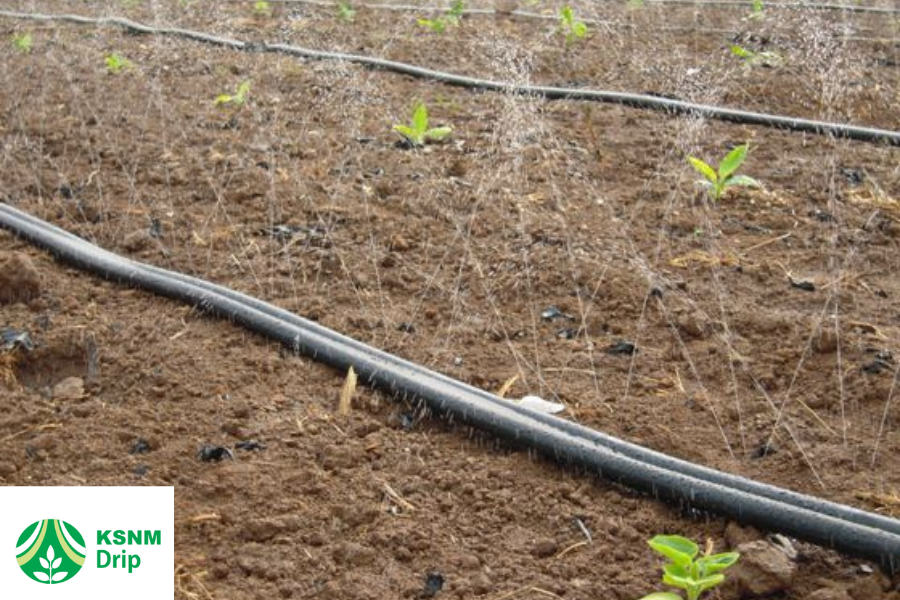Posted On: April 25, 2024
Posted By: KSNM DRIP

Rain Hose Irrigation is a modern and efficient method of watering crops, mimicking natural rainfall to deliver water directly to the root zone of plants. Using nano-punching technology, the flexible hose ensures uniform water distribution while saving water and labor costs. Understanding how this system works and implementing proper maintenance is essential for maximizing its effectiveness and ensuring healthy plant growth.
Rain hose irrigation is a type of spray irrigation method where water is sprayed and applied to the crops in a uniform and cost-effective manner, saving water and labor costs. It is designed to mimic the natural rainfall and deliver water directly to the root zone of the plants. The rain hose is a flexible hose with a pattern of drip holes, which are made with nano-punching technology to ensure a uniform flow of water.
With the help of nanotechnology, a flexible sturdy tube is punctured at equal intervals to make small holes. When pressurized water is sent through the tube water is sprayed through these small holes imitating rain. The tube is placed in a way that the holes are pointed towards the plants. This makes the process of irrigation more effective, making sure that the crops get the necessary amount of water and nutrients.
However good the rain hose irrigation system is made and set, you should always look out for it, if you are not maintaining it well, there are chances of failure in your irrigation system. Regular maintenance is suggested to make your rain hose irrigation system work for a long time.
Clogging: Over time, dirt, debris, and mineral deposits from the water can accumulate inside the hose's perforations, leading to clogging. This reduces the flow of water and affects the uniformity of irrigation.
Uneven Water Distribution: Clogging or damage to the hose can cause uneven water distribution along its length. Some plants may receive too much water, while others may not receive enough, leading to uneven growth and potential crop damage.
Leaks: Damaged or worn-out sections of the hose can develop leaks, causing water to escape before reaching the intended plants. This not only wastes water but also reduces the effectiveness of the irrigation system.
Reduced Efficiency: A poorly maintained rain hose irrigation system is less efficient in delivering water to plants. It may require longer watering times to compensate for reduced water flow, leading to increased water usage and higher water bills.
Plant Stress: Inadequate or irregular watering due to a poorly maintained system can stress plants, making them more susceptible to diseases, pests, and environmental stressors. This can ultimately reduce crop yields and quality.
System Damage: Neglected rain hose irrigation systems may suffer from deterioration, such as cracks, breaks, or deterioration of connectors. This can lead to more significant repairs or the need for a complete replacement of the system.
Increased Maintenance Costs: Ignoring maintenance can lead to more significant problems over time, resulting in higher repair or replacement costs for the irrigation system.
To prevent these issues, regular maintenance of the rain hose irrigation system is essential. This includes cleaning the hose regularly, checking for leaks or damage, and replacing any worn-out or damaged parts promptly. Regular inspections and proper care can help ensure the efficient operation of the system and healthy plant growth.
Maintaining a rain hose irrigation system is crucial for its efficient operation and the health of your plants. Here are some general maintenance tips to keep your system in good working condition:
Clean the rain hose periodically to remove dirt, debris, and mineral deposits that can clog the perforations. Use a soft brush or sponge and mild detergent to gently scrub the hose. Rinse thoroughly with water afterward.
Check the entire length of the drain hose for any signs of damage, such as cracks, punctures, or leaks. Pay close attention to connectors and fittings as well. Replace any damaged components promptly to prevent water wastage and ensure uniform watering.
Ensure that the area around the rain hose is free from obstructions such as weeds, rocks, or other debris that could interfere with water flow or damage the hose. Trim vegetation and remove debris regularly to maintain clear access to the hose.
Periodically check the positioning of the rain hose to ensure that it is properly aligned with the plants to be watered. Adjust the placement as needed to ensure even coverage and to accommodate changes in plant growth or layout.
Check the water pressure at the source to ensure it is within the recommended range for the rain hose irrigation system. Excessive pressure can damage the hose or cause uneven watering. Use a pressure regulator if necessary to maintain optimal pressure.
If you live in a region with cold winters, take precautions to protect the rain hose from freezing temperatures. Drain the hose and store it indoors during the winter months to prevent damage from freezing and thawing.
Perform seasonal maintenance tasks such as flushing the system before the start of the growing season to remove any accumulated debris or sediment. Inspect the system for any wear and tear and address any issues before they worsen.
Keep a record of maintenance activities, including cleaning, inspections, and repairs. This will help you track the condition of the system over time and identify any recurring issues that need attention.
By following these maintenance tips, you can ensure that your rain hose irrigation system operates efficiently, providing consistent and reliable watering for your plants while minimizing water waste and maximizing plant health.
Rain Hose Irrigation offers a sustainable and cost-effective solution for crop watering needs. By following the provided maintenance tips, users can ensure the longevity and efficiency of their irrigation systems, leading to improved crop yields and resource conservation. Embracing this innovative technology empowers farmers to achieve optimal results while contributing to environmental preservation and agricultural sustainability.